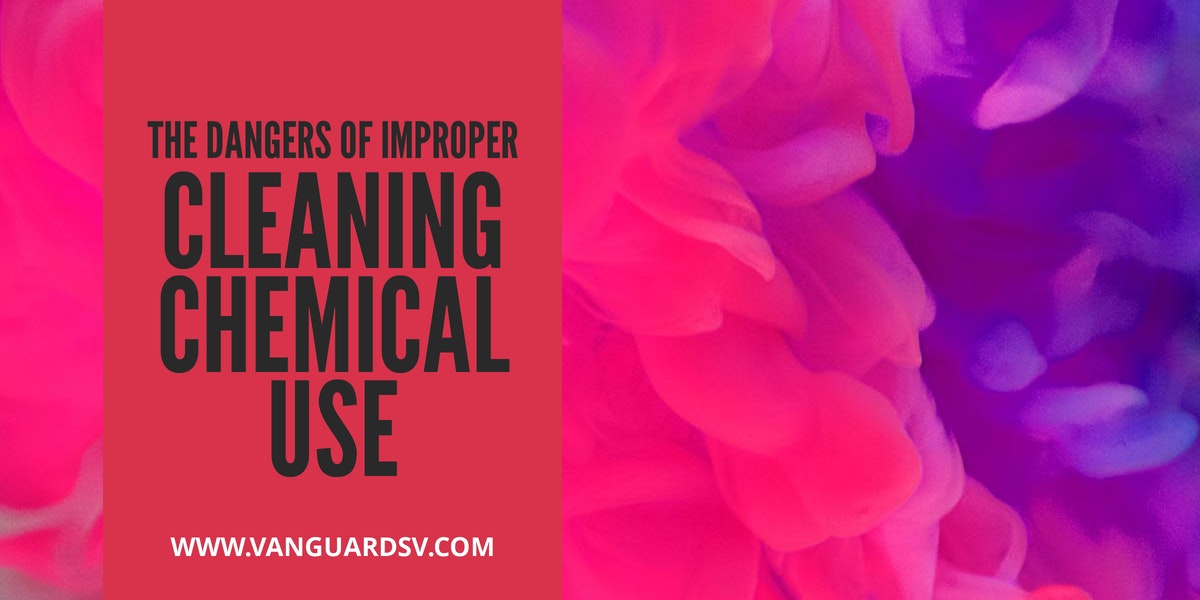The improper use of cleaning chemicals and machinery poses serious health risks to custodial staff and building occupants--potentially leading to life-long illnesses or even death.

Mishandling Cleaning Products Is Dangerous
Conventional home and commercial cleaning products are made from toxic chemicals that are dangerous to humans and animals.
Their use, manufacture, and storage are heavily regulated by State and Federal governments.
The regulations are due to the often corrosive or dangerously poisonous nature of the cleaning products when mishandled, misused, or mixed with other cleaning products.
Case in point--a recent accident involving two custodial employees who improperly mixed water into a bottle of drain cleaner and shook it up, resulting in the evacuation of a local resort and the hospitalization of both workers.
According to Park City Fire District spokesperson Tricia Hurd Hazelrigg;
They added water, which is what you would do normally, but once it's in the drain with a measured amount.
They took the jug, and added the water to the jug and then shook it up.
When the employee noticed the container swelling, people in the area were notified and evacuated, except for the person who mixed the container and one other employee.
The first employee attempted to remove the lid to relieve pressure, but the contents of the container spewed, and the container ruptured, spilling chemicals on the two employees and on the walls of the surrounding area.
[...] the patients’ breathing was affected by the chemical; one patient’s eyes were affected; and one of them was burned on the arm and torso.
Chemical Cleaner Accident Affects Two Employees At Red Pine Lodge
Outlining the Dangers of Handling Chemical Cleaning Products
According to the U.S. Environmental Protection Agency (EPA), 2.8 million custodial workers are exposed to toxic cleaning products every day, and it is up to the employer to ensure safe use and training, as well as proper handling and storage.
Consider some of the most commonly used cleaning products:
- Bleach - A corrosive product whose liquid and vapors can irritate the skin, eyes, nose, and throat. Direct contact can result in dermatitis. Accidental ingestion can result in esophageal injury, stomach irritation, and prolonged nausea and vomiting. Mixing bleach with other cleaning products, especially ammonia, can result in toxic vapors, which can cause severe breathing problems.
- All Purpose Cleaners - Depending on the ingredients used, all-purpose cleaners can irritate the skin, eyes, nose, and throat. They can be highly poisonous to both humans and animals if swallowed.
- Laundry Detergent - Overexposure to laundry detergent can result in asthma, depending on the type and length of exposure, and are responsible for numerous poisonings from accidental ingestion/swallowing.
- Antibacterial Cleaners - Typically contains pesticides--quaternary ammonium or phenolic chemicals--which can irritate your eyes and burn your skin and throat.
- Window/Glass Cleaner - Can irritate the eyes, nose, and throat and, if swallowed, can lead to drowsiness, unconsciousness or death.
- Toilet Bowl Cleaner - Most products are very irritating to your eyes and skin and will burn your throat.
- Furniture Polish - Contains chemicals that can irritate your skin, eyes, throat, lungs, and windpipe and lead to nausea and vomiting if swallowed.
- Air Fresheners - Contain chemicals that have been linked to cancer and brain damage, are usually highly flammable, and in solid form can lead to death if eaten by people or pets.
Source:
Safe Handling Recommendations
With the proper training and documentation, it is possible to avoid any accidental hazardous exposure to toxic cleaning chemicals.
- Document all cleaning products located within the facility, including volumes, storage locations, potential hazards, and necessary precautions.
- Keep safety data sheets in the cleaning closet where cleaning products are stored and update them regularly with the most current information.
- Always wear appropriate protective gear.
- Do not mix chemicals or store cleaning products in anything other than their original container, and;
- Install safety signage to alert workers to the potential hazards involved with the use of cleaning products.
References & Resources
- Two Cleaning Employees Hospitalized After Improper Chemical Use
- Common Cleaning Products Can Be Dangerous When Mixed
- Six Tips on the Safe Handling of Cleaning Chemicals
Takeaway
The handling of any chemical is potentially hazardous, and the cleaning industry is no exception.
Proper training and documentation can alleviate many of the issues associated with toxic chemical exposure.
However, eliminating the use of these products in favor of safer for use or certified green cleaning products can significantly improve the indoor air quality, health, and safety of your facility, resulting in improved performance and wellbeing for all building occupants.
If you would like to learn more about the advantages to environmentally-safe green cleaning products, how to manage your current chemical cleaning products, or if you would like to schedule a free, no-obligation onsite walkthrough of your facility, contact us today for a free quote!
In Bakersfield CA, call (661) 437-3253
In Fresno CA, call (559) 206-1059
In Valencia CA, or Santa Clarita CA, call (661) 437-3253

